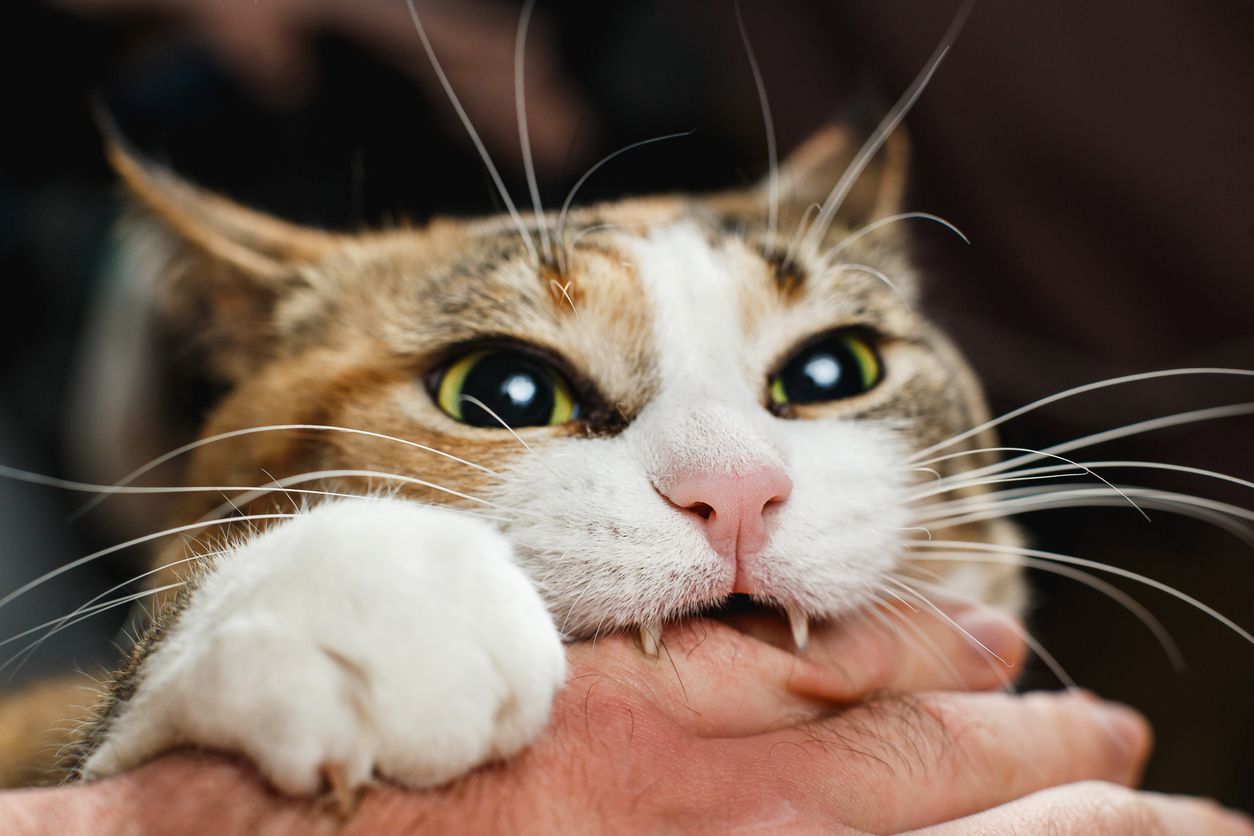Why cats bite and how to stop them

We love our cats—even when they make it hard to do so. Sure, some cats are straight-up love fluffs, or at least disinterested window ornaments with a fixation on the bird in the oak tree. But you may find the kitty you picked out at the shelter turned into a tiger once you got them home.
From little bitty nips to full-on chomps, cats of all kinds will occasionally bite their owners. Sometimes cat bites occur rather frequently. And that may have you wondering: why do cats bite their owners?
We’ll answer that question below. We’ll also tell you if it’s a cause for concern, what to do about it, and how to avoid getting bitten by an aggressive cat in the first place.
Why do cats bite their owners?
One thing we love about cats is their stalwart independent streak. But that sure makes things difficult when they’re on the bitey side. So why do cats bite their owners? Cats bite as a form of communication. This isn’t really a major revelation. If you couldn’t speak, were highly skittish, and possessed a latent kill instinct, you too, might act the way a cat does. So what exactly are they trying to communicate? Let’s examine a few common reasons why cats bite.
1. Kitten teething
Are you easily frustrated by teething animals? Then you picked the wrong pet: Kittens teethe twice—once at around three weeks of age and again at around 12 weeks. And it can take approximately six months for their teeth to come in fully. A cat’s gums get sore during and after tooth eruption, just like yours did all those years ago.
Teething—biting and gnawing on objects or people to ease (and, in the latter case, transfer) that discomfort—is perhaps easy to empathize with. But it can be tough to live with. Make sure you have lots of chewable toys around. Rubber teething rings, tough-hided mouse toys, that sort of thing.
Do your best to redirect kitty away from your fingers and toward those toys. This is the sort of care that pays off forever. A cat’s behavior is influenced by the environment of its youth, and setting good patterns early can help nip biting behavior in the bud before your familiar’s gnarly adult teeth come in.
2. Play aggression
News to no one: cats are weird. They’re fussy, compulsively clean, and orderly, yet they see a dead animal as the perfect accessory missing from your welcome mat.
Cats possess a natural sense of play, challenge, and competition. But they also possess a keen hunting instinct. That means play can quickly get a bit rough—as far as people are concerned. Domestic cats weren’t always domestic. That means housecats have, deep in their genome, an inherent urge to do what their wild ancestors did: hunt stuff.
You may not think your cat is hunting when they play, but that surprising bite suggests otherwise. It’s just their natural instincts coming out. Again, toys are your friends here, especially ones you can dangle in front of your little Garfield. It simulates a live, huntable animal without the cleanup, allowing your cat to get some “kills” in the safest, least messy way possible.
3. Love bites
Yup, biting indicates love, too. Did we mention cats are weird? So-called love bites are probably a cat’s unintentionally painful way of grooming you: they’re showing you the care their mother showed them as newborns. And as fastidiously clean animals, they may go in for a deep cleaning—which would seem to require taking off a layer of your skin.
You never want to punish your cat for biting, and doing so would be especially confusing for them here. After all, they think they’re being sweet. Just move away, distract them with a toy, and try to understand that love looks different from one species to another.
4. Sudden biting when petting
Cats enjoy being petted…until they don’t. That’s why you need to be careful and watch for certain signs of “Okay I’m done now.” These “unprovoked” acts of aggression are, well, not actually aggression per se. Cats are highly reactive. Petting may overstimulate them, leading to erratic, defensive behavior such as biting.
In some cases, biting when being pet could be a symptom of feline hyperesthesia syndrome, which is extreme skin sensitivity in a certain area. If your cat snaps their head around quickly, starts making other jerky movements, or their flesh begins to quiver, they may be telling you it’s time to wrap things up. And if you aren’t sure, they’ll clarify with a sharp chomp to your hand.
5. Fear
You’ve seen your cat jump from the bookcase onto the kitchen counter. They’re not afraid of cars, vacuum cleaners, or new people, and they’re an apex predator at heart. So it might seem like your cat doesn’t have the capacity for fear. But they do. Of course they do. Poor socialization can cause a hyperacute fear instinct. And punishment worsens it.
Remember what we said about establishing good behaviors and habits early? It applies here, too. A happy, comfortable cat is less likely to find itself afraid or agitated by new things. If your cat is displaying fear behavior, take good notes. Figure out their triggers and avoid them to whatever extent you can.
Maybe they don’t like other people. In fact, they might just not like you. As when any two personalities come together for the first time, you have to have to feel out your dynamic. Especially at the beginning. By means of slow exposure and letting them work things out on their own, such behavior can be overcome.
How to tell if your cat is about to bite
You should learn to read your cat’s body language carefully. Signs that a cat may be preparing to bite include:
- Flattening back of the ears
- Tail swishing
- Gripping you with its claws
Pets have individual personalities, so there may be other signs. You and your feline pal just need to take the time to learn about one another. Be patient.
How to get your cat to stop biting you
Establishing good no-biting habits early is important. Start correcting your cat’s behavior during kittenhood if possible, or at least as soon as you bring them home. And remember not to make yourself available to bite: social encounters should occur on your cat’s terms.
Keep lots of toys around—the kind they can bite and scratch at. The name of the game here is distraction. Cats don’t recognize positive and negative reinforcement the way dogs do. It can be kind of a chess game to get a cat to do what you want them to do. But biting behavior shouldn’t be tolerated, so stock up on those toys.
Know the difference between love bites and real bites: one isn’t a response to negative stimuli; the other is. So be sure to watch for triggers—fear, aggression, etc.—and avoid them when possible. And always remember to let social encounters happen on your cat’s terms. Forcing play or interactions with other pets, guests, or children when your cat doesn’t want them may result in a bite. Give your kitty some space. They’ll come to you when they want to (maybe).
The right way to pet your cat
Cats aren’t really social. And they’re fussy. So you can’t divebomb them with scratches like you can a dog. So how do you overcome biting? Well, remember that cats don’t always like to be petted as often as you like to pet them. Each cat is an individual with specific preferences on when and how they like to be pet.
Try petting your cat in these general areas and closely observe how they react:
- Under the chin
- Around the cheeks
- At the base of the ears
Face stuff, basically. And rather than reaching directly for your cat, let them come to you. A cat is more likely to feel comfortable if they think they’re in control. Watch for signs like tail swishing or fur quivering that may suggest your cat is not enjoying the pets and back off. It may take time, but your cat will make it clear what kind of petting they prefer.
Signs of an aggressive cat
Avoid approaching an aggressive cat. These cats are using their body language to warn you to back off or else—they may be forced to bite you if you don’t heed the warning.
Signs that a cat may be aggravated include:
- Holding their tail erect
- Dilated pupils
- Spitting
- Hissing
- Twitching skin
- A raised paw
- Vocalizations that aren’t purrs
- Back arching
Again, there may be other signs, too—highly individual ones specific to your cat. Noticing these signs and giving kitty lots of room is the best way to avoid bites.
What to do if you have an aggressive cat
Some cats are more territorial than others, and there’s just nothing you can do about that. So don’t approach an aggressive cat. Let them come to you. If they do let you pet them, watch out for signs that they want you to stop.
In some cases, there may be a medical reason why your cat is acting out aggressively. They could have:
- Arthritis
- Tooth abscesses
- Hyperesthesia Syndrome
- Hyperthyroidism
- Liver diseases
- Brain disorders
- Lead poisoning
- Infectious diseases
If you're concerned about biting/aggression and want to speak to a qualified professional, book an online virtual care appointment to discuss the issue wherever is most convenient for you and your cat. And be sure to look into our new kitten checklist so you’re getting things right from day one.



